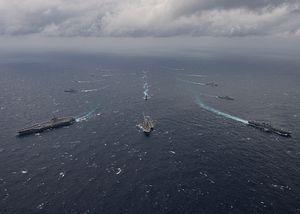From October 7 to 15, India and Japan held the third edition of the Japan-India Maritime Exercise (JIMEX) in Visakhapatnam, in southern India. While the exercise is indicative of better bilateral defense ties between the two sides, the strategic message by New Delhi is less clear.
In recent years, interactions between the Indian and Japanese militaries have grown tremendously. The two navies have been coordinating anti-piracy missions in the Gulf of Aden. Japan is also a permanent participant in the Malabar series of naval exercises since 2015, which originally started between the Indian and U.S. navies in 1992. The Malabar 2018 trilateral exercises were held off Guam in June.
The JIMEX series is designed to create better interoperability, ensure better understanding, and share best practices between the two navies. JIMEX-18, the third one in the series, is taking place after a gap of five years and is demonstrative of the worsening maritime scenario in the Indo-Pacific and the greater coincidence of interests between New Delhi and Tokyo especially in the defense and security arena. The last JIMEX took place off the Chennai coast in December 2013.
Despite India’s ambiguous tone from time to time on the Indo-Pacific strategic concept and the Quad, the revival of the India-Japan maritime exercise underlines the growing concern in the two capitals about the threats to the freedom of navigation and respect for international rules of the road in the Indo-Pacific. JIMEX-18 also reflects the growing comfort level and sophistication of India-Japan military ties, which are informed by the closer strategic vision shared by Prime Ministers Narendra Modi and Shinzo Abe.
But whether or not this represents India’s broader strategic alignment with states such as the United States and Japan as part of an effort to balance against China and ensuring a free and open Indo-Pacific (FOIP) as envisioned by Washington is less clear.
In that sense, the JIMEX exercises are another example of the apparent inconsistent Indian approach to the Indo-Pacific that is likely to confuse both India’s partners as much as China. On the one hand, the fact that it was restarted after five years appears to suggest that India is intent on partnering with other countries to dealing with challenges that China’s rise poses.
More broadly, over the last several months, India has sent several signals to this effect. It signed the COMCASA (Communications Compatibility and Security Agreement) with the United States, and conducted bilateral maritime exercises with Australia, in addition to joining the Australian-led multilateral Pitch Black air combat exercise for the first time and the India-Singapore joint naval exercise SIMBEX.
However, over the last few months, India has also taken steps that can only create concerns among the same potential partners. For one, after the Wuhan Summit between Modi and Xi, India’s approach to China appears to have considerably softened, as indicated by Prime Minister Modi’s Shangri-La Dialogue keynote speech back in June. In addition, India has also refused to allow Australia to join the Malabar exercises – despite Australia expressing a keen desire to do so. That would have brought India together with other key potential players in the Indo-Pacific.
India also attended the Senior-Level official meeting of the Quad in June, but it seemed quite lukewarm about the idea. Most recently, India has signed a deal with Russia for the S-400 anti-aircraft systems and Indian government oil companies announced that it was buying more oil from Iran in November, both of which will raise tensions with the United States, a key partner.
Thus, despite restarting the JIMEX exercise, India’s approach continues to show incoherence. To be sure, it is not uncommon for states to hedge their bets. But Indian political and bureaucratic leaders need to consider the effect of such mixed signaling and aim for more consistent policy or if there is an underlying logic to it, explain it better to India’s partners and observers.
































